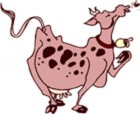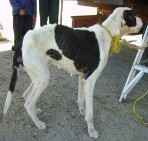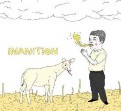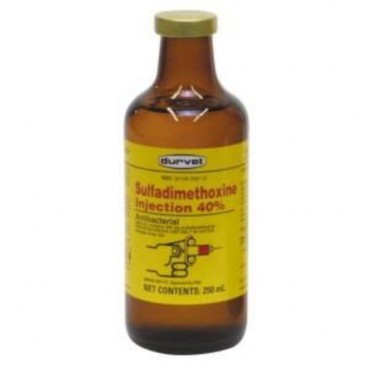


7.
8.
9.

10.
Exercise 2: Look at the pictures and write the correct spellings for the words.
Có thể bạn quan tâm!
-
 Reading: Read The Following Words And Do The Exercise That Follow.
Reading: Read The Following Words And Do The Exercise That Follow. -
 Vocabulary: Translate The Following Words Into Vietnamese And Learn By Heart Them.
Vocabulary: Translate The Following Words Into Vietnamese And Learn By Heart Them. -
 Vocabulary: Translate The Following Words Into Vietnamese And Learn By Heart Them.
Vocabulary: Translate The Following Words Into Vietnamese And Learn By Heart Them. -
 Giáo trình Anh văn chuyên ngành dùng chung Nghề Dịch vụ thú y và chăn nuôi - Cao đẳng - Trường Cao đẳng Cộng đồng Đồng Tháp - 9
Giáo trình Anh văn chuyên ngành dùng chung Nghề Dịch vụ thú y và chăn nuôi - Cao đẳng - Trường Cao đẳng Cộng đồng Đồng Tháp - 9
Xem toàn bộ 75 trang tài liệu này.



1. RINEAXOA 2. CENMIAOTAI 3. MVTOI



4. FESNADES 5. NASMELES 6. TAHAPY



7. MOCA 8. ITANNOINI 9. HAERDAIR



10. SAANEU 11. LOROD 12. CEHA
Supplementary Reading: AVIAN INFLUENZA (FOWL PLAGUE)
http://wwwmerckvetmanual.com
1. Etiology and Epidemiology:
The causal orthomyxoviruses are type A influenza viruses. Both virulent and avirulent viruses with any of 14 known surface hemagglutinins infect avian species. The viruses grow readily in embryonating chicken eggs and agglutinate RBC. Specific hemagglutination inhibition is the basis for the serological test for influenza antibodies. The viruses are distributed worldwide and recovered frequently from clinically normal sea birds, migrating waterfowl, imported pet birds, ratites, and species in live bird markets.
2. Clinical Findings and Lesions:
The incubation period is highly variable and ranges from a few days to 1 week. Signs range from only a slight decrease in egg production or fertility to a fulminating infection with CNS involvement, but respiratory signs are most common. Other common signs in severely affected birds are greenish diarrhoea; cyanosis and edema of the head, comb, and wattle; discoloration of the shanks and feet due to ecchymoses; and blood-tinged oral and nasal discharges. Sinusitis is not uncommon in ducks, quail, and turkeys.The location and severity of gross lesions are also highly variable and may consit of hemorrhages, transudation, and necrosis in the respiratory, Gl, integumentary, and urogenital systems.
3. Diagnosis:
Isolation of the virus in embryonating chicken eggs results in allantoic fluid that agglutinates RBC. The hemagglutination is not inhibited by Newcastle disease antiserum. A crude antigen prepared by grinding the chorioallantoic membrane of infected chicken embryos gives positive results with a gel- precipitation test using known positive influenza A antiserum. If severe, the disease resembles acute fowl cholera ( Fowl Cholera: Introduction) and velogentic, viscerotropic Newcastle disease (Newcastle Disease: Introduction). In milder forms, it may be confused with other respiratory diseases.
4. Prevention and Treatment:
The use of nonviable oil-emulsion vaccine is complicated by the 14 antigenically distinct hemagglutinin subtypes that may be responsible for the disease. To be effective, the vaccine must be produced using the autogenous virus or a virus of the same hemagglutinin type. The other major viral surface antigen, neuraminidase, is not as important in influenza immunity as the hemagglutinin ( but is useful for identification ). Treating affected flocks with broad-spectrum antibiotics to control secondary bacterical invaders and
increasing house temperatures may help reduce mortality. Amantadine hydrochloride, approved for treatment of influenza A in man, reduces the severity of influenza in some avian species, but amantadine-resistant virus frequently emerges. Suspected outbreaks should be reported to regulatory authorities.
Chapter 7
DRUGS & DIRECTIONS FOR USE SHEET MH38 - 07

In this Chapter
Objective:
By the end of the Chapter, learners are able to
Know the form of directions for use sheet and understand
the meaning of items in directions for use sheet.
1. Vocabulary: Translate the following words into Vietnamese and learn by heart them.
Drug (n)= medicine (n) :
Indication (n) :
Action (n) :
Toxicity (n) :
Safety (n) :
Limitation (n) :
Precaution (n) :
Dosage (n) :
Administration (n) :
How supplied :
Warning (n) :
Treatment (n) :
Contraindication (n) :
Interaction (n) :
Adverse reaction :
Description (n) :
Over dosage (n) :
2. Reading: Read the following text and do the exercises that follow.
DRUGS & DIRECTIONS FOR USE SHEET
ALBON®
(sulfadimethoxine)
Injection 40%
Each mL contains 400 mg of sulfadimethoxine.
Caution: Federal law restricts this drug to use by or on the order of a licensed Veterinarian.
INDICATIONS FOR USE:
Dogs and Cats: For the treatment of sulfadimethoxine-sensitive bacterial infections in dogs and cats and bacterial enteritis associated with coccidiosis in dogs. (See Section 1)
Cattle: For the treatment of bovine respiratory disease complex (shipping fever complex) and bacterial pneumonia associated with
Pasteurella spp. Sensitive to sulfadimethoxine: necrotic pododermatitis (foot rot) and calf diphtheria caused by Fusobacterium necrophorum (Sphaerophorus necrophorus) sensitive to sulfadimethoxine.(See Section 2.)
DESCRIPTION: Albon Injection 40% is a low-dosage, rapidly absorbed, long-acting sulfonamide, effective for the treatment of a wide range of bacterial infections commonly encountered in dogs and cats; the treatment of shipping fever complex, bacterial pneumonia, calf diphtheria, and foot rot in cattle.
Sulfadimethoxine is a white, almost tasteless and odorless compound.
Chemically, it is N l-(2,6-dimethoxy-4-pyrimidinyl) sulfanilamide.
Section 1Dogs and Cats
ACTIONS: Sulfadimethoxine has been demonstrated clinically or in the laboratory to be effective against a variety of organisms, such as streptococci, klebsiella, proteus, shigella, staphylococci, escherichia, and salmonella. These organisms have been demonstrated in respiratory, genitourinary, enteric, and soft tissue infections of dogs and cats. The systemic sulfonamides which include sulfadimethoxine are bacteriostatic agents. Sulfonamides competitively inhibit bacterial synthesis of folic acid (pteroylglutamic acid) from para-aminobenzoic acid. Mammalian cells are capable of utilizing folic acid in the presence of sulfonamides.
The tissue distribution of sulfadimethoxine, as with all sulfonamides is a function of plasma levels, degree of plasma protein binding and subsequent passive distribution in the tissues of the lipid-soluble un-ionized form. The relative amounts are determined by both its pKa and by the pH of each tissue. Therefore, levels tend to be higher in less acid tissue and body fluids or those diseased tissues having high concentrations of leucocytes. In the dog, sulfadimethoxine is not acetylated as in most other animals, and it is excreted predominantly as the unchanged drug. Sulfadimethoxine has a relatively high solubility at the pH normally occurring in the kidney, precluding the possibility of precipitation and crystalluria. Slow renal excretion results from a high degree of tubular reabsorption and plasma protein binding is very high, providing a blood reservoir of the drug. Thus, Sulfadimethoxine maintains higher blood levels than most other long-acting sulfonamides
Single, comparatively low doses of Albon give rapid and sustained therapeutic blood levels.
To assure successful sulfonamide therapy the drug must be given early in the course of the disease, and it must produce a high sulfonamide level in the body rapidly after administration, therapeutically effective sulfonamide levels must be maintained in the body throughout the treatment period, treatment should continue for a short period of time after the clinical signs have disappeared, and the causative organisms must be sensitive to this class of drugs. TOXICITY AND SAFETY: Data regarding acute and chronic toxicities of sulfadimethoxine indicate the drug is very safe. The LD50 in mice is greater
than 2 g/kg of body weight when administered intraperitoneally and greater than 16 g/kg when administered orally. In dogs receiving massive single oral doses of
3.2 g/kg of body weight, diarrhea was the only adverse effect observed. Dogs given 160 mg/kg of body weight orally daily for 13 weeks showed no signs of toxicity.
INDICATIONS: Albon Injection 40% is indicated for the treatment of a wide range of respiratory, genitourinary tract, enteric, and soft tissue infections.
For example:
Tonsillitis, pustular dermatitis, pharyngitis anal gland infections, bronchitis, abscesses pneumonia, wound infections, cystitis, bacterial enteritis, nephritis, canine salmonellosis metritis, bacterial enteritis associated with coccidiosis in dogs, pyometra
When caused by streptococci,staphylococci, escherichia, salmonella, klebsiella, proteus or shigella organisms sensitive to sulfadimethoxine.
LIMITATION: Sulfadimethoxine is not effective in viral or rickettsial infections, and as with any antibacterial agent, occasional failures in therapy may occur due to resistant microorganisms.
The usual precautions in sulfonamide therapy should be observed.
PRECAUTIONS: During treatment period make certain that animals maintain adequate water intake.
If animals show no improvement within 2 or 3 days consult your veterinarian.
Intramuscular administration is not recommended. Some animals treated by the intramuscular route exhibit signs of pain during and for a few minutes following such injections, and in dogs blood levels are lower than those obtained by intravenous treatment.
DOSAGE AND ADMINISTRATION: Albon Injection 40% is recommended only for administration by the intravenous route. Usually the injectable formulation may be used to obtain effective blood levels almost immediately or to facilitate treatment of the fractious animal, and the oral formulations utilized for maintenance therapy. However, the injectable formulation may be used for the entire course of Albon therapy when indicated.
Dogs and cats should receive 1 mL of Albon Injection 40% per 16 lb of body weight (55 mg/kg) as an initial dose, followed by 1/2 mL per 16 lb of body weight (27.5 mg/kg) every 24 hours thereafter. Representative weights and doses are indicated in the following table:
Each mL contains 400 mg of sulfadimethoxine.




